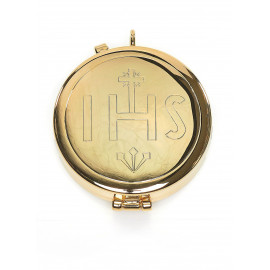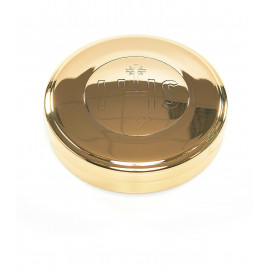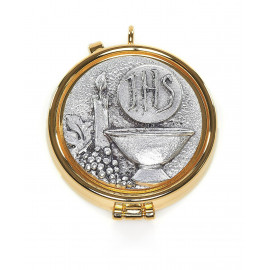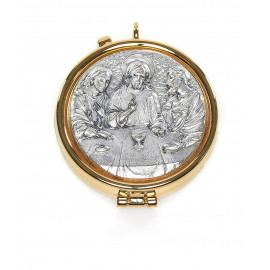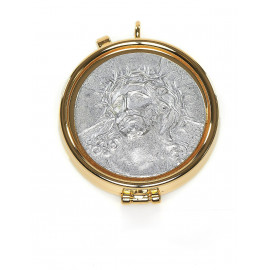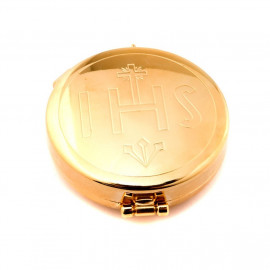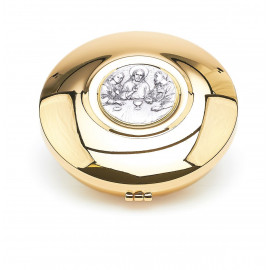No products
Product successfully added to your shopping cart
There are 0 items in your cart. There is 1 item in your cart.
Catholic Pyx
- Altar Bell and Gong
- Candle Snuffer
- Candlestick
- Catholic Pyx
- Chalices
- Church wall lamps
- Ciborium
- Crosses and Crucifix
- Cruets & Trays
- Holy Water Font
- Holy Water Pot
- Missal Stand
- Monstrance Tabor
- Monstrances
- Offering Baskets
- Oil Stock
- Patens
- Reliquaries
- Sanctuary Bells
- Sanctuary Lamp
- Sprinkler
- Thurible, Boat, & Spoon
- Travel Liturgy & Mass Kit
A Catholic pyx is a small container used to store and transport the Eucharist, which is the consecrated host. It is used to carry the Blessed Sacrament to the sick or home bound, and to repose the consecrated host in the tabernacle. Pyxes are also used to keep low gluten hosts separated from gluten hosts. They are often carried by priests, deacons, or extraordinary ministers to bring the Eucharist to people outside a church. Pyxes are usually small, flat, clamshell-style containers, often about the size of a pocket watch and usually made of brass or other metals, traditionally lined with gold. A fabric or leather pouch in which the pyx may be carried is known as a burse. Burse is a case or pouch designed to hold a pyx, and a cord is usually attached so that the pyx may be placed inside and then worn about the neck, close to the heart of the person carrying the Blessed Sacrament.
A Catholic pyx is a small container used to store and transport the Eucharist, which is the consecrated host. It is used to carry the Blessed Sacrament to the sick or home bound, and to repose the consecrated host in the tabernacle. Pyxes are also used to keep low gluten hosts separated from gluten hosts. They are often carried by priests, deacons, or extraordinary ministers to bring the Eucharist to people outside a church. Pyxes are usually small, flat, clamshell-style containers, often about the size of a pocket watch and usually made of brass or other metals, traditionally lined with gold. A fabric or leather pouch in which the pyx may be carried is known as a burse. Burse is a case or pouch designed to hold a pyx, and a cord is usually attached so that the pyx may be placed inside and then worn about the neck, close to the heart of the person carrying the Blessed Sacrament.
Catholic Pyx There are 7 products.
Understanding the Catholic Pyx: A Sacred Vessel
The Catholic Pyx is a small, yet profoundly significant container within the Catholic Church. Its primary purpose is to carry the Consecrated Host, the Eucharist, to those who are unable to attend Mass due to illness or other reasons. This sacred vessel ensures that all members of the Catholic community can partake in Holy Communion, regardless of their physical condition.
The Historical Significance of the Pyx
The term "Pyx" originates from the Greek word "pyxis," which means boxwood receptacle, a nod to the material originally used to create these containers. Over the centuries, the design and materials of the Pyx have evolved, but its sacred purpose has remained unchanged. From gold-plated brass to intricately designed silver, the Pyx has been a symbol of reverence and devotion within the Catholic faith.
The Design and Use of the Pyx
Typically, a Catholic Pyx is small, flat, and often resembles a clamshell or a pocket watch in design. It is traditionally lined with gold, a material chosen for its purity and resistance to corrosion, symbolizing the incorruptible nature of the Eucharist contained within. The Pyx is carried in a burse, a fabric or leather pouch that can be securely closed and attached to the person transporting the Holy Communion, ensuring the sacred contents are treated with the utmost respect and care.
The Pyx in Modern Times
In today's Catholic Church, the Pyx continues to play a vital role in ministering to the sick and homebound. It allows priests, deacons, or extraordinary ministers to bring the Eucharist to those unable to attend Mass, ensuring that all members of the Catholic community are included in the sacrament of Holy Communion. The Pyx is not only a vessel for the Body of Christ, but also a symbol of the Church's mission to care for all its members.
FAQs About the Catholic Pyx
What materials are used to make a Catholic Pyx?
Catholic Pyxes are usually made of brass or other metals and are traditionally lined with gold. This choice of materials ensures durability and symbolizes the sacredness of the Eucharist.
Can anyone carry a Pyx?
Typically, a Pyx is carried by a priest, deacon, or an extraordinary minister who has been authorized to bring the Eucharist to the sick or home bound.
How is the Pyx transported?
The Pyx is often carried in a burse, a specially designed pouch that can be securely closed and attached to the person carrying it. This ensures the Eucharist is transported with reverence and care.
Is the Pyx used only for the sick?
While its primary use is to bring the Eucharist to those unable to attend Mass, the Pyx also symbolizes the Church's broader mission of care and inclusion, reminding us of the importance of reaching out to all members of the community.
The Pyx: A Symbol of Faith and Inclusion
The Catholic Pyx is more than just a container; it is a profound symbol of the Catholic Church's commitment to ensuring that all its members can partake in the sacrament of Holy Communion. Through its use, the Church demonstrates its dedication to caring for the sick and home bound, embodying the teachings of Christ to love and serve one another. The Pyx, in its simplicity and sacredness, continues to be a vital instrument of faith and inclusion within the Catholic community.

